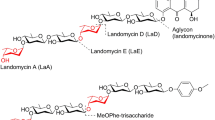Abstract
MarA, the 129-amino-acid (aa) protein which plays a crucial role in the multiple antibiotic resistance (Mar) phenotype inEscherichia coli, shows homology to members of the XylS/AraC family of transcriptional regulators. Although these proteins vary in size from around 100 to 350 aa they all contain a DNA-binding domain with a helix-turn-helix motif. The larger ones, e.g., XylS, AraC, and Rob, contain an additional domain either at their amino- or at their carboxy-terminus. This domain is important for effector-binding or dimerization or of unknown function. MarA consists only of the DNA-binding component. Nevertheless, a sequence with a coding potential of 141 aa upstream of its ATG start-codon showed 20.5–26.9% aa identity with the corresponding section within the effector-binding domain of XylS from the TOL plasmid ofPseudomonas putida when translated in the same reading frame as MarA. However, the reading frame was interrupted by 11 translational stops. In another frame, this upstream sequence actually codes for a real protein, MarR, that is completely unrelated to XylS. Implications for the putative evolution of regulatory proteins through translocation of domains followed by adaptation are discussed.
Similar content being viewed by others
References
Amabile-Cuevas CF, Demple B (1991) Molecular characterization of thesoxRS genes ofEscherichia coli—two genes control a superoxide stress regulon. Nucleic Acids Res 19:4479–4484
Ariza RR, Cohen SP, Bachhawat N, Levy SB, Demple B (1994) Repressor mutations in themarRAB operon that activate oxidative stress genes and multiple antibiotic resistance inEscherichia coli. J Bacteriol 176:143–148
Bustos SA, Schleif RF (1993) Functional domains of the AraC protein. Proc Natl Acad Sci USA 90:5638–5642
Cohen SP, Hächler H, Levy SB (1993a) Genetic and functional analysis of the multiple antibiotic resistance (mar) locus inEscherichia coli. J Bacteriol 175:1484–1492
Cohen SP, Levy SB, Foulds J, Rosner JL (1993b) Salicylate induction of antibiotic resistance inEscherichia coli—activation of themar operon and amar-independent pathway. J Bacteriol 175:7856–7862
Cohen SP, McMurry LM, Levy SB (1988) ThemarA locus causes decreased expression of OmpF porin in multiple-antibiotic-resistant (Mar) mutants ofEscherichia coli. J Bacteriol 170:5416–5422
Gallegos M-T, Michan C, Ramos JL (1993) The XylS/AraC family of regulators. Nucleic Acids Res 21:807–810
Gambino L, Gracheck SJ, Miller PF (1993) Overexpression of the MarA positive regulator is sufficient to confer multiple antibiotic resistance inEscherichia coli. J Bacteriol 175:2888–2894
George AM, Levy SB (1983) Gene in the major cotransductional gap of theEscherichia coli K-12 linkage map required for the expression of chromosomal resistance to tetracycline and other antibiotics. J Bacteriol 155:541–548
Greenberg JT, Chou JH, Monach PA, Demple B (1991) Activation of oxidative stress genes by mutations at thesoxQ/cfxB/marA locus ofEscherichia coli. J Bacteriol 173:4433–4439
Hächler H, Cohen SP, Levy SB (1991)marA, a regulated locus which controls expression of chromosomal multiple antibiotic resistance inEscherichia coli. J Bacteriol 173:5532–5538
Inouye S, Nakazawa A, Nakazawa T (1986) Nucleotide sequence of the regulatory genexylS on thePseudomonas putida TOL plasmid and identification of the protein product. Gene 44:235–242
Kessler B, Marques S, Kohler T, Ramos JL, Timmis KN, De Lorenzo V (1994) Cross talk between catabolic pathways inPseudomonas putida: XylS-dependent and -independent activation of the TOL meta operon requires the same cis-acting sequences within the Pm promoter. J Bacteriol 176:5578–5582
Ramos JL, Michan C, Rojo F, Dwyer D, Timmis KN (1990a) Signal-regulator interactions. Genetic analysis of the effector binding site of XylS, the benzoate-activated positive regulator of thePseudomonas TOL plasmid meta-cleavage pathway operon. J Mol Biol 211:373–382
Ramos JL, Rojo F, Zhou L, Timmis KN (1990b) A family of positive regulators related to thePseudomonas putida TOL plasmid XylS and theEscherichia coli AraC activators. Nucleic Acids Res 18:2149–2152
Schollmeier K, Hillen W (1984) Transposon Tn10 contains two structural genes with opposite polarity betweentetA andIS10R. J Bacteriol 160:499–503
Seoane AS, Levy SB (1995a) Identification of new genes regulated by themarRAB operon inEscherichia coli. J Bacteriol 177:530–535
Seoane AS, Levy SB (1995b) Characterization of MarR, the repressor of the multiple antibiotic resistance (mar) operon inEscherichia coli. J Bacteriol 177:3414–3419
Skarstad K, Thoeny B, Hwang DS, Kornberg A (1993) A novel binding protein of the origin of theE. coli chromosome. J Biol Chem 268:5365–5370
Sulavik MC, Gambino LF, Miller PF (1994) Analysis of the genetic requirements for inducible multiple-antibiotic resistance associated with themar locus inEscherichia coli. J Bacteriol 176:7754–7756
Sulavik MC, Gambino LF, Miller PF (1995) The MarR repressor of the multiple antibiotic resistance (mar) Operon inEscherichia coli: prototypic member of a family of bacterial regulatory proteins involved in sensing phenolic compounds. Mol Med 1:436–446
Wallace RG, Lee N, Fowler AV (1980) ThearaC gene ofEscherichia coli: transcriptional and translational start-points and complete nucleotide sequence. Gene 12:179–190
Yan W, Cohen SP, Levy SB (1992) Three putative proteins in themar operon mediate intrinsic multidrug resistance inEscherichia coli. 92th Annu Meet Am Soc Microbiol, New Orleans, Abstr No. A-26, p 5
Author information
Authors and Affiliations
Rights and permissions
About this article
Cite this article
Hächler, H., Cohen, S.P. & Levy, S.B. Untranslated sequence upstream of MarA in the multiple antibiotic resistance locus ofEscherichia coli is related to the effector-binding domain of the XylS transcriptional activator. J Mol Evol 42, 409–413 (1996). https://doi.org/10.1007/BF02498634
Received:
Accepted:
Issue Date:
DOI: https://doi.org/10.1007/BF02498634




